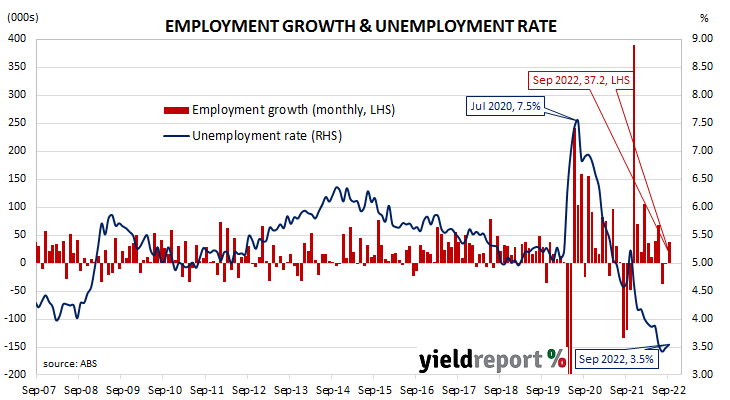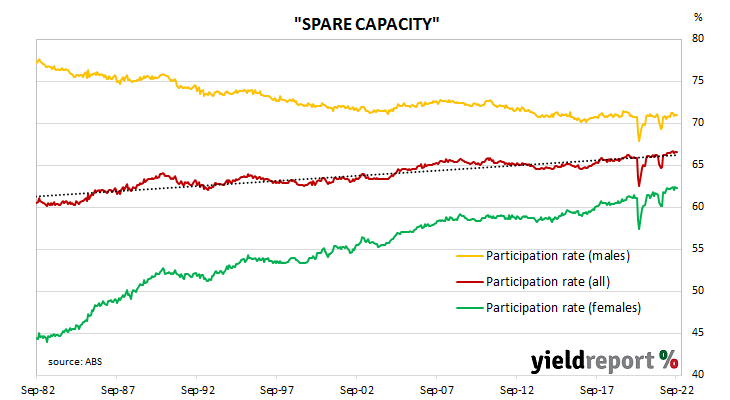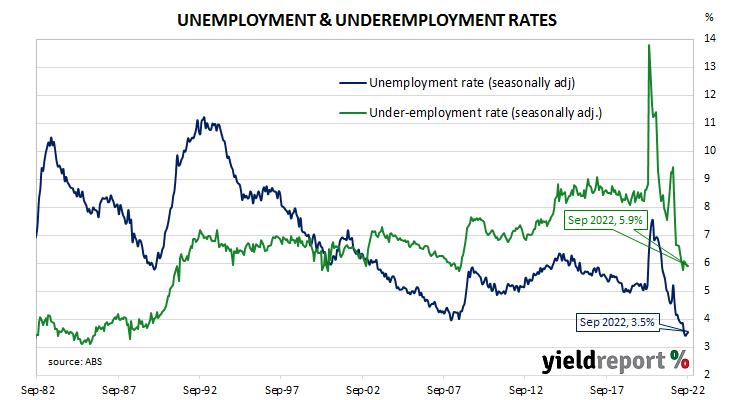Summary: Employment up just 900 in September, considerably less than expected; labour market “troughing” but forward indicators “still at quite strong levels”; participation rate unchanged at 66.6%; jobless rate steady at 3.5%; fewer part-time, more full-time jobs; aggregate work hours steady; underemployment rate steady at 5.9%.
Australia’s period of falling unemployment came to an end in early 2019 when the jobless rate hit a low of 4.9%. It then averaged around 5.2% through to March 2020, bouncing around in a range from 5.1% to 5.3%. Leading indicators such as ANZ’s Job Ads survey and NAB’s capacity utilisation estimate suggested the unemployment rate would rise in the June 2020 quarter and it did so, sharply. The jobless rate peaked in July 2020 but fell below 7% a month later and has since trended lower.
The latest Labour force figures have now been released and they indicate the number of people employed in Australia according to ABS definitions increased by just 900 in September. The small rise was considerably less than the 25,000 increase which had been generally expected as well as August’s 36,300 gain.
“The labour market looks to be troughing, although most forward indicators are still at quite strong levels,” said Morgan Stanley Australia economist Chris Read. “Expect a more meaningful deterioration to come early next year.”
Domestic Treasury bond yields rose considerably on the day, outpacing the overnight rises of their US Treasury counterparts. By the close of business, the 3-year ACGB yield had gained 12bps to 3.70% while 10-year and 20-year yields each finished 11bps higher at 4.08% and 4.39% respectively.
In the cash futures market, expectations regarding future rate rises hardened. At the end of the day, contracts implied the cash rate would rise from the current rate of 2.56% to average 2.83% in November and then increase to an average of 3.035% in December. May 2023 contracts implied a 3.935% average cash rate while August 2023 contracts implied 4.16%.
The participation rate remained unchanged from August’s figure of 66.6% as the total available workforce increased by 9,700 to 14.090 million while the number of unemployed persons increased by 8,800 to 499,400. As a result, the unemployment rate remained steady at 3.5% as the higher jobless figure was offset by the larger workforce.
The aggregate number of hours worked across the Australian economy essentially remained steady as 12,400 residents lost part-time positions and 13,300 residents gained full-time positions. In percentage terms, the total number of work hours was flat after rising by 0.4% in August. On a 12-month basis and after revisions, aggregate hours worked increased by 7.1% as 196,200 more people held part-time positions and 495,000 more people held full-time positions than in September 2021.
In recent years, more attention has been paid to the underemployment rate, which is the number of people in work but who wish to work more hours than they do currently. September’s underemployment rate remained unchanged at 5.9%, just above May’s recent low of 5.8%.
The underutilisation rate, that is the sum of the underemployment rate and the unemployment rate, has a strong correlation with the annual growth rate of the ABS private sector wage index when advanced by two quarters. September’s underutilisation rate of 9.4% corresponds with an annual growth rate of about 4.7%.




